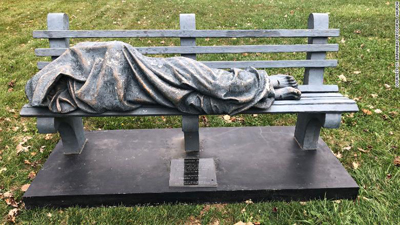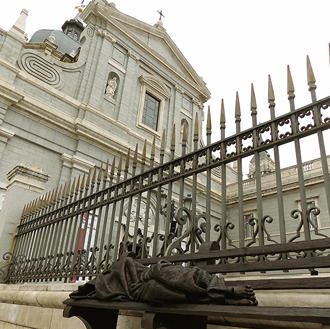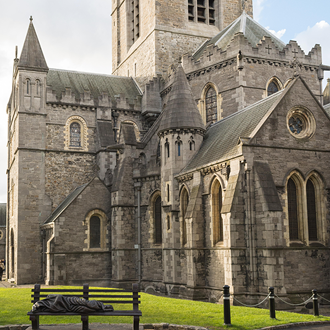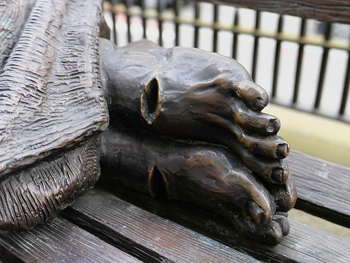For Sunday [month] [day], 2016
Lectionary Readings (Revised Common Lectionary, Year A)
Ezekiel 34:11-16, 20-24
Psalm 95:1-7a
Ephesians 1:15-23
Matthew 25:31-46
In early 2013, Canadian sculptor Timothy Schmalz unveiled “Homeless Jesus,” a bronze sculpture depicting Jesus as a homeless person, sleeping on a park bench. Schmalz installed the original sculpture at Regis College, University of Toronto, and since then, casts have been installed worldwide. The sculpture is designed in such a way that Jesus is huddled beneath a blanket, his face and hands obscured. Only the crucifixion wounds on his feet reveal his identity.
A devout Catholic, Schmalz describes the sculpture as a “visual translation” of our Gospel reading for this week, in which Jesus identifies himself with the hungry, the thirsty, the stranger, the naked, the sick, and the prisoner, and then tells his followers: “Whatever you did to one of the least of these who are members of my family, you did it to me.”
Not surprisingly, reactions to the statue vary. Some people find it offensive. Others adore it. Pope Francis has blessed it. People sit and pray beside it. In one city, a woman called the police within minutes of the sculpture’s installation, assuming that the figure beneath the blanket was a real homeless person.
This week the Church celebrates the Reign of Christ, a liturgical hinge between the long “Season After Pentecost,” and the beginning of Advent. We pause this week to reflect on the meaning of Christ's reign over the Church, the world, and our lives. What kind of king is Jesus? What does his rule look and feel like? What does it mean to live and thrive under his kingship?
 |
Given the power and pageantry we typically associate with kings, we might expect the lectionary to give us readings that sound, well, kingly. Something gorgeous from the Book of Revelation, perhaps, about Jesus decked out in splendid robes and a jeweled crown. Or something majestic from Isaiah: "A son will be given to us, and the government will rest upon his shoulders." Or at least a shiny moment from the Gospels: Jesus transfigured on the mountaintop. Jesus raising Lazarus from the dead. Jesus emerging from the waters of baptism, heaven thundering in his ears.
But no. The royalty Jesus describes in Matthew’s Gospel is of another order, entirely. It is homeless Jesus. Sick Jesus. Imprisoned Jesus. Hungry Jesus. Naked Jesus. It is, in the words of Episcopal theologian Fleming Rutledge, the “royalty that stoops.”
I learned this week that “Reign of Christ” Sunday is a fairly recent addition to the Western liturgical calendar. Pope Pius XI instituted it in 1925, in the hope that a world ravaged by World War I might find in Jesus’s humble kingship a needed alternative to empire, nationalism, consumerism, and secularism.
I love the Pope’s vision, but I fear it has not been realized. As I write this essay, Covid-19 cases are soaring across the United States, not least because millions of people are refusing outright to wear masks and practice social distancing. What is that, if not a refusal to see and tend to Jesus in our most vulnerable neighbors? Is not our sick king even now lying in thousands of hospital beds, struggling to breathe? Is not our king hungry, thirsty, and naked after months of Covid-induced unemployment? Isn’t Jesus even now languishing in a million prison cells, feeling utterly expendable as the coronavirus rips through our jails and prisons?
 |
I fear that instead of embracing the countercultural possibility of a humble, wounded king, we have given ourselves over to a version of kingship that is all about domination, supremacy, triumphalism, and greatness. We have fallen in love with the loud, the muscular, and the aggressive, and forgotten that the only power Jesus wielded on earth was the power to give himself away. He’s the king who entered humanity red-faced and crying, a king whose greatest displays of power included riding on a donkey, washing dirty feet, hanging on a cross, and frying fish on a beach for his agnostic friends. How did we go from this God of kenosis — the God who empties himself of all privilege, the God who perpetually pours himself out and surrenders his own life for his loved ones — to God as Iron Man?
So many of us, in our devotional and ecclesiastical lives, long to “see Jesus.” And rightly so. We pray for an experience of Jesus’s presence. We yearn to feel him close. We sing hymns, recite creeds, hear sermons, and attend Bible studies — all in the hope of seeing and knowing Jesus in a deeper and more meaningful way.
Of course, there is nothing wrong with these practices — unless they keep us at comfortable arm’s length from where Jesus actually is. Unless they lead us to believe that the work of justice and compassion is somehow secondary to the “real” business of Christianity. The real business of Christianity is bending the knee to Jesus. And where is Jesus? Jesus is in the least and the lost and the broken and the wounded. Jesus is in the un-pretty places. In the bodies we don’t discuss in polite company. In the faces we don’t smile at. In the parts of town we speed by.
It’s not that we earn our way to majestic King Jesus by caring for the vulnerable. It is that majestic King Jesus, by his own choice and volition, has stooped and surrendered in such a way that he IS the vulnerable. There’s no other way to get to him. Period.
 |
So what is it in us that turns away when Jesus offers us his whole self in such provocative, unbearable simplicity? This is a real question — one I wrestle with all the time. What am I afraid of? My inadequacy? My vulnerability? My reputation? Jesuit theologian James Keenan defines mercy as “the willingness to enter into the chaos of others.” Is that what we’re afraid of? Other people’s chaos?
The thing is, it’s okay to be afraid. It's okay to have questions. It's okay to see the huddled figure on the bench, and not know exactly what to do. But at some point, our fears must come face to face with reality: “Whatever you did to one of the least of these who are members of my family, you did it to me.” There is simply no way around it. Not if we take Jesus’s kingship seriously.
Likewise, there is no way around the perplexing fact that our lectionary reading — a reading that describes the final judgment of all humanity — says nothing about belief. Think about that. Matthew 25 depicts a scene from the heavenly throne room. It’s a scene describing the culmination of history, when all nations will gather before Christ, and Christ will separate his people as a shepherd separates sheep from goats. Notice the criteria he'll use for the separation. What will it be? Not our confessions of faith. Not our beliefs, not our doctrinal commitments, not our “personal relationships” with Jesus. The criteria will be compassion, and compassion alone.
Surprised? I am. But yes, this is our king, and yes, we are meant to be provoked and bewildered by his priorities. As Fleming Rutledge puts it, “The Son who ‘sits upon his glorious throne with all the nations gathered before him’ is the same one who, at the very apex of his cosmic power, reveals that the universe turns upon a cup of water given to the littlest ones in his name.”
 |
If we’re not at least a little bit unnerved, then we’re not paying enough attention.
Soon, we will enter into Advent, a season of waiting, longing, and listening. Soon we will walk into the expectant darkness, waiting for the light to dawn, for the first cries of a vulnerable baby to redefine kingship, authority, and power forever. But on this Sunday, here and now, we are asked to see Jesus in places we’d rather not look. We are asked to remember that every encounter we have with “the least of these” is an actual encounter with Jesus. It’s not a metaphor. It’s not wordplay. It’s not optional. The person huddled beneath the blanket is our king. Let's see him.
Debie Thomas: debie.thomas1@gmail.com
Image credits: (1) CNN; (2) Sculpture by Timothy P. Schmalz; (3) Sculpture by Timothy P. Schmalz; and (4) Wikipedia.org.





